Aquatic Resources
Lewis River Spawning Surveys
PacifiCorp 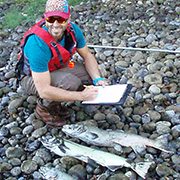
Meridian field biologists perform annual
spawning surveys upstream of Swift Dam to
determine the spawn timing, distribution, and
abundance of transported anadromous fish (coho
and spring Chinook) to support an overall
assessment of the success of the anadromous
fish reintroduction program upstream of the
Lewis River Hydroelectric Projects. We also
conduct seasonal spawning surveys downstream
of Merwin Dam to quantify coho spawning
escapement. Survey methods include walking,
drift boat, raft, kayak and jetboat as
conditions dictate. Meridian manages data
entry, data analysis, and reporting.
Lewis River Juvenile Salmonid Out-migration Monitoring
PacifiCorp 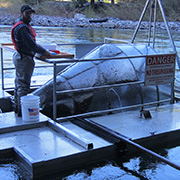
Meridian field biologists operate three rotary
screw traps in the North Fork Lewis River
basin to quantify the number of out-migrant
salmonids that enter Swift Reservoir and
downstream of the three-dam complex. Meridian
assists with trap installation and operate the
traps 7 days per week for approximately 4
months each year. During each daily trap
check, we measure and mark a subset of all
salmonids collected in the trap with PIT tags
or tattoo marks and release fish upstream to
estimate trap efficiency. Meridian conducts
all data entry, analysis and reporting to
estimate total out-migrants by species and
life stage at each trap location. Species
handled typically include cutthroat, rainbow,
and bull trout; coho and Chinook salmon;
large-scale sucker, northern pike-minnow,
lamprey, whitefish and sculpin.
Bull Trout Limiting Factors Analysis
PacifiCorp 
Meridian designed and conducted a limiting
factors analysis of bull trout in tributaries
to Lake Merwin and Swift Creek Reservoir. We
developed a set of physical habitat criteria
for each life stage, and collected fish
presence, water temperature, and habitat data
to rate 16 streams based on these criteria.
The Qualitative Habitat Assessment (QHA)
method was applied to define limiting factors
by life stage for each stream. Results of QHA
were used to rank streams for potential bull
trout restoration.
Surgical Implantation Procedure Training for Juvenile Salmonid Acoustic Tagging
Upper Skagit Tribe 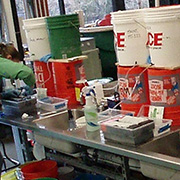
Meridian trained Upper Skagit Tribe staff in
methods to surgically implant acoustic tags
into juvenile salmonids to support an
assessment of steelhead life history in the
Skagit River basin. Meridian developed an
acoustic tagging protocol and training
materials, and conducted in-person training
and post-training evaluation of tagger
performance in the field. Training including
preparation of videos on suture knot tying and
written and classroom presentations on aseptic
techniques, tagging station setup, fish
anesthesia procedures, surgical tag
implantation procedures, and fish recovery
post-tagging.
Ruby and Big Beaver Creek Bull Trout Distribution and Spawner Abundance Pilot Study
Seattle City Light 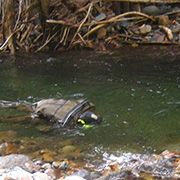
Meridian developed and implemented a study to
estimate bull trout spawner abundance and
distribution in two tributaries to Ross Lake
within the North Cascades National Park. Bull
trout spawner abundance and distribution were
assessed using snorkel-based surveys. Total
abundance was estimated using relationships
observed between habitat type and snorkel
counts (using aerial photo interpretation and
in-field habitat mapping). Changes in
potential spawning habitat distribution and
total abundance were also assessed by
comparing results to surveys conducted more
than 15 years prior.
Resident Trout Limiting Factors Analysis
Snohomish County PUD 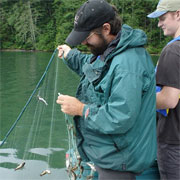
In cooperation with the University of
Washington, Meridian biologists designed and
conducted field studies for a resident trout
limiting factors analysis in Spada Lake. We
collected and integrated data on the fish
species assemblage; the size, parasite load,
and abundance of trout and brown bullhead; and
fish forage base (zooplankton and neuston)
distribution and abundance.
Klamath Shortnose Sucker Conservation Aquaculture Assessment
US Fish and Wildlife Service, with DJ
Warren & Associates
Since being listed as endangered in the
Klamath River Basin, the USFWS has sought to
protect the diminishing habitat of the native
Lost River sucker, but then turned to hatchery
options to preserve the species and aid in
their recovery. Meridian was part of the team
that evaluated eight sites throughout the
basin to assess the following: a water supply
that could be permitted, sufficient space for
hatchery facilities and operator housing,
biosecurity for a listed species, site access,
and potential to obtain regulatory approval.
Analyses and recommendations were provided to
the USFWS.
Columbia River Hatchery Scientific Review Group
Bonneville Power Administration and NOAA
Fisheries
Meridian staff provided documentation and
technical support to the Hatchery Scientific
Review Group (HSRG) in evaluating over 300
hatchery programs in the interior Columbia
River Basin. Our biologists compiled
background information about each salmonid
population affected by hatchery programs that
provided the basis for HSRG member
recommendations. Meridian prepared all
population and ESU reports and maps to
document the work of the HSRG and identify how
to recover and conserve naturally spawning
populations, and support sustainable
fisheries.

